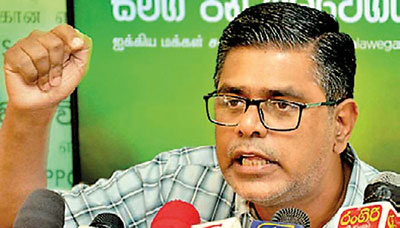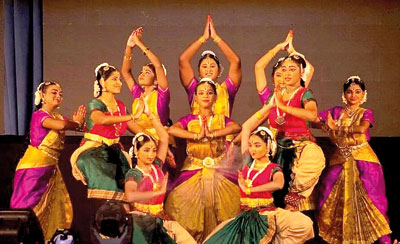Columns
President’s committee red flags port’s container release as illegal
View(s):- SJB MP Mujibur Rahman blows the lid off the scandal at Colombo Port
The scandalous arbitrary release of 323 red-flagged containers from Colombo port, without a mandatory physical inspection carried out to expeditiously clear a supposed port backlog, was illegal, a committee appointed by the President has found.
The bombshell findings of the committee’s damning report were first revealed by SJB MP Mujibur Rahman on Monday in Parliament, where he tabled the committee’s report, which delivered a strong indictment on the port authorities.
“This report was handed over to the President on June 12,” MP Mujibur told the House. “Though more than two weeks have passed, it has still not been made public. Neither was it tabled in Parliament. Since the government has shown no inclination to table it, at least we must do it.”
Mujibur said, “The report says the Director General of Ports had appointed a committee and empowered it to clear red-flagged containers after mandatory inspections had been carried out. Although they say they acted with good intentions to clear the backlog, their actions have violated Customs procedure as laid down in the Customs Ordinance.
Furthermore, the inquiry committee report had cast doubts on whether there had been a genuine backlog of containers piled up at the port.
“The committee,” Mujibur said, “had pointed out that on several dates, the number of containers released was a modest 13 on one occasion and 63 on another, calling into question whether congestion was truly the driving force. In this regard, the committee had noted, “If the policy had been genuinely aimed at clearing backlogs, Customs senior management should have transparently notified all divisions and applied proper safeguards to track the released containers.”

SHOCK REVELATION: Rahman reveals hitherto undisclosed port scandal report
The committee also noted that although the Director General of Customs has been given ‘general authority’ to carry out the functions of the Customs Department in terms of Section 2 of the Customs Ordinance, the Act does not give him any express or implied power to deviate from accepted procedures.
The whole modus operandi to clear the port backlog in double quick time by releasing the red-flagged containers, without any physical inspections, was illegal.
The Customs Ordinance holds that mandatory physical inspections must be done on all red-flagged containers before releasing them from port. But this compulsory legal requirement seems to have been thrown overboard by port officials on the spurious grounds of expediency in their mad rush to clear the port backlog.
The port scandal was first brought to light by the President of the Customs Trade Union Alliance, Amila Sanjeeva, who, on January 22, told reporters at a press conference, “The containers marked in red by the computer system were flagged for higher inspection. Once red-flagged, these 323 containers required mandatory inspection. But it had been cleared and released without any mandatory inspection done.”
“On whose legal authority?” he asked, “and under what law were the 323 red-flagged containers released from the port?”
Does anyone have the authority to override the provisions of the law? Does anyone have the authority to cast to the winds the prescribed manner in which even a single red-flagged container can be cleared from port and, on the pretext of a port backlog, release red-flagged containers, irrespective of what they contain?
If such illegalities had taken place in the past, it’s no valid precedent to quote to justify its present violation nor to absolve its present preparators. No man in the land has the right to violate any section in an Act, unless an exception contained in the Act confers on him the right to do so.
Two days after the Customs Trade Union President had first revealed the port scandal, the Deputy Minister of Port, Kodithuwakku, confirms in Parliament the release of 323 red-flagged containers and, what’s more, says, “The government would assume full responsibility for the recent release of 323 containers from Sri Lanka Customs without inspections.”
One wonders then, as one wonders now, how he, or anyone else, could take responsibility for goods inside 323 unopened containers on which no mortal man had ever laid eyes, unless he’s divinely blessed with omniscience?
However, the wonder ceases to amaze when, nearly five months later, the Port’s media spokesman, the Additional Director General of Customs, Seevali Arukgoda, awakes from his long leisurely slumber to hold a press conference on June 7 to tell the media that he exactly knew what was inside the red-flagged containers, not from what he had dreamt in sleep or seen manifested in his crystal ball but from what was written on the customs declarations by importers, describing the nature of the goods inside these 323 red-flagged containers at the port.
Seevali Arukgoda said the 323 controversial shipping containers released without inspection were industrial goods and raw materials, according to the documents declared by the importers before they were released.
He said, “Sri Lanka Customs believe the contents were as declared by the importers and can assure the containers did not carry arms or drugs.” Arukgoda added, “These imported containers contained raw materials needed for industries, such as plastics, yarn, chemicals, automobile spare parts, animal feed, machinery, pesticides, cement, iron pipes, fertilisers, and wood.”
Did he expect any importer to write down on his customs declaration form 300 T56 machine guns and 10,000 rounds of ammunition or 500 kilos of heroin?
He stated that all necessary steps were taken to release the containers only after thoroughly checking the import documents. He said that by following this simple procedure, he believed the containers did not contain any illegal goods.
Belief alone cannot justify departing from the mandatory provisions of the Customs Ordinance, which, as the committee report says, does not give anyone the express or implied power to deviate from accepted procedures.
He ended his ‘shedding of light’ ritual on the controversial issue by stating, “I can confirm that no external or political party influenced the container release process. I can say that with absolute certainty.”
The committee recommended a post-audit to ascertain whether any economic loss had occurred as a result of releasing these red-flagged containers without physical inspections.
But can a post-audit, even a forensic one for that matter, help when not even a trace of evidence exists. It’s like finding a black cat in a black room that is not there.
The Port Scam displays all the signs of turning out to be another Bond Scam to send the nation on another manhunt to find the elusive mastermind. Their only difference, as Dilith Jayaweera said in Parliament this week, ‘In the Bond Scam, at least, we had some figures to go by. In the Port Scandal, we have none.’
The people can only ask without receiving an answer and dread if these red flag containers had held enough weapons and ammo to equip an armoury for terrorists, or held enough narcotic drugs to make this country, a nation of drug addicts, or had contained a massive stock of inferior or past-the-shelf-date medicinal drugs to be administered to patients at government hospitals.
Speaking at a media briefing on Friday, SJB’s Mujibur Rahman said he wasn’t happy with the inquiry committee’s terms of reference. “The committee’s mandate was limited to determining whether these containers were released outside standard procedures.”
If the going rate for causing a 50 million rupee loss to the state 10 years ago is 20 years, how many years do you fancy a minister or a public servant will get for causing a loss of a billion rupees to the state in 5 years’ time?
| Kathirgamam brought to life in Bharatha Natyam spectacle How Kathirgamam gained its name and enduring fame as the sacred abode of Lord Murugan will be retold this month in step and dance by over a hundred dancers in a Bharatha Natyam spectacle to burst on stage in Colombo this month.  KALASURI: Thivya Sujen Nestled in its forest bosom, suckled by the waters of the Manik, Kathirgamam’s bewitching enchantment, that enticed Murugan to take residence incarnate with his wife, Thevani, and consort, Vallie, at this idyllic spot in south Lanka, will come alive on stage when the Muse of Bharatha Natyam, Saraswathie, is invoked by these disciples of southern India’s ancient art form to bring its past to animated life. It will be a rapturous cultural spectacular that will unfold when the Abhinayakshetra School of Dance, under Kalasuri Thivya Sujen, presents ’Kathirgamam,” a grand dance drama that brings to the stage the myth-enriched history of one of Lanka’s most sacred shrines. It premieres on the 20th of July at 6 p.m. at the New Kathiresan Hall, Colombo-4. This monumental production is said to be the first of its kind to portray the vibrant legacy of the Kathirgamam Temple through classical dance and evocative music. More than 100 dancers from the Abhinayakshetra School of Dance, together with top Bharatha Natyam dancers from India, will perform at this Bharatha Natyam extravaganza that is hailed by its presenters as a ‘mesmerising fusion of culture and religious devotion.’ This bevy of dancers will retell the story of Kathirgamam’s fabled past through intricate footwork, subtle or dramatic gestures and narrative movement found in Bharatha Natyam techniques, choreographed to the music composed by renowned artists Dr. Rajkumar Bharathi and Sri Sai Shravanam, who have collaborated with India’s famed maestro musician A.R. Rahman. The organisers say they have “drawn from meticulous historical research to showcase stories that span centuries, celebrating the temple’s sacred rituals like the Yatra and Yogam,” the union and pilgrimage. This opera in dance focuses on the magnetic appeal Kathirgamam exerts on people of different religious beliefs. As turbulent rivers rush to merge as one in the great blue sea, all roads of diverse faiths lead to Kathirgamam to unite as one on its hallowed soil. The Sinhala Buddhists call it Kataragama, the forest abode of Kataragama Deviyo, or Skanda Kumaru, one of the four guardian deities protecting the island and the Buddha Sasana. Lankan Hindus call it Kathirgamam, dedicated to Lord Murugan, also known as Skanda-Murukan. Lankan Muslims call it Khidr-gama, or ‘home of al-Khidr,’ a revered figure in Islamic tradition, while Lankan Catholics render homage to the forest abode’s resident god, Lord Kataragama, as one of the deities enshrined in the island’s multi-religious pantheon. Transcending religious blasphemies and manmade religious divides, the devout, bathed and cleansed of religious differences, emerge from the banks of the Manik River to step on the pristine shores of Kataragama or Kathirgamam or Khidr-gama, united in one spiritual quest in peace and harmony as equal children of Mother Lanka. It is the golden thread that runs through the entire tapestry of this Bharatha Natyam spectacle, emphasising with every step taken and every gesture made in dance, the common bond of unity between all four great religions found extant in Kathirgamam’s shared religious heritage. It makes Abhinayakshetra School’s presentation of ‘Kathirgamam’ not merely a performance in classical dance but a profound national odyssey in search of divine peace and religious, cultural harmony. | |
 TROUPE MOVEMENT: In Bharatha Natyam’s classical step, the dance of Kathirgamam |
Buying or selling electronics has never been easier with the help of Hitad.lk! We, at Hitad.lk, hear your needs and endeavour to provide you with the perfect listings of electronics; because we have listings for nearly anything! Search for your favourite electronic items for sale on Hitad.lk today!


Leave a Reply
Post Comment